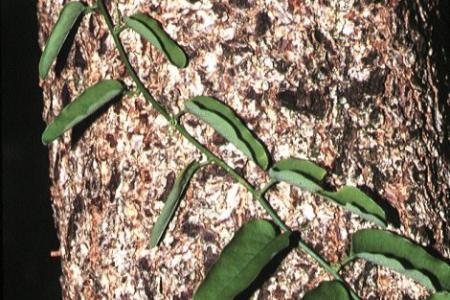
SUBGENUS: deidamioides
SECTION: tryphostemmatoides
GEOGRAPHICAL DISTRIBUTION OR ORIGIN:
Ecuador
MINIMUM TEMPERATURE: 12 °C
IDEAL MINIMUM TEMPERATURE: 15 °C
ETYMOLOGY: Refers to the apices of tendrils which are shaped like diskettes, so as to attach themselves to the bark of the trees as suction cups
DESCRIPTION:
The most evident peculiarity of this plant is the method it uses to cling to supports, which differs from that of most other passionflowers. Its tendrils are branched at the ends and terminate with 3 or 4 rigid hooks. As they grow, they are stiff and rotate slowly until they touch something rough, such as the bark of a tree, which they can securely hold onto. They then consolidate their grip and the hooks adapt to the roughness of the trunk. In order for the stem to adhere to the plant, the tendrils shorten themselves by curling up like springs. By doing this, P. discophora always manages to grow stuck to trees, imitating the behaviour of the common ivy and the Canadian vine (Parthenocissus tricuspidata). The shoots that have failed to take hold or that have been blown off by the wind remain trailing towards the ground.
Its natural habitat is the tropical forest of Ecuador where it is found clinging to the trees on which it climbs to reach the light.
It has very interesting flowers: the corolla, with a diameter of 4 cm, is pure white and the corona of filaments, made up of 3 series, is intense yellow in the centre and white at the apex. The filaments are therefore bicoloured and the transition from yellow to white, which is predominant, is clear and sudden. The petals and sepals are bent slightly back, while the corona is stretched forward. Flowering only occurs in very large specimens and so requires waiting a few years due to the plant's slow growth.
This plant, which is glabrous in its entirety, has whole, elliptical narrow leaves, slightly tapered at the ends, up to 5 cm long and equipped with a pair of glands at the petiole attachment. The stems are thin, cylindrical and bear singular tendrils at each node.
It is easy to cultivate and is resistant to water stress and diseases. Due to its poor resistance to cold, it must be grown in pots and kept at a temperature not lower than 10°C in winter. During the summer, starting from April in northern Italy, it can be placed in the garden, burying the pot at the foot of a tree and helping it to cling to the bark at first. It will then be able to grow by itself exactly as it does in nature. When autumn arrives, it can be gently removed to be brought indoors.
The seed's mode of germination is peculiar and rare in the genus Passiflora since the cotyledons do not open as is normally the case, but remain underground, enclosed in the integument. On the surface, you will see the epicotyl appear already endowed with traces of the first true leaves. Propagation with cuttings is easy and provides sure results.